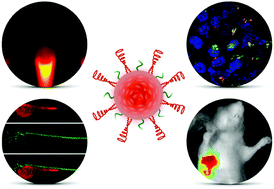Multilayered semiconducting polymer nanoparticles with enhanced NIR fluorescence for molecular imaging in cells, zebrafish and mice†
Abstract
Although organic semiconducting polymer nanoparticles (SPNs) have emerged as an important category of optical imaging agents, their application in molecular imaging is still in its infancy and faces many challenges. We herein report a straightforward one-pot synthetic approach to construct multilayered near-infrared (NIR) fluorescent SPNs with enhanced fluorescence and optimized biodistribution for in vivo molecular imaging. In addition to the SP core, the multilayered SPNs have a middle silica protection layer and an outer poly(ethylene glycol) (PEG) corona, which play crucial roles in enhancing the NIR fluorescence by up to ∼100 fold and reducing nonspecific interactions, respectively. Their proof-of-concept imaging applications are demonstrated in cells, zebrafish and living mice. The multilayered nanoarchitecture not only permits in vivo lymph node tracking with an ultrahigh signal-to-noise ratio (∼85), but also allows for more sensitive in vivo imaging of tumors with a fluorescence intensity ratio of tumor to liver that is ∼8-fold higher compared to that of the counterpart silica SPN. Thus, this study provides a simple yet effective nanoengineering approach to facilitate the application of SPNs in molecular imaging.


 Please wait while we load your content...
Please wait while we load your content...